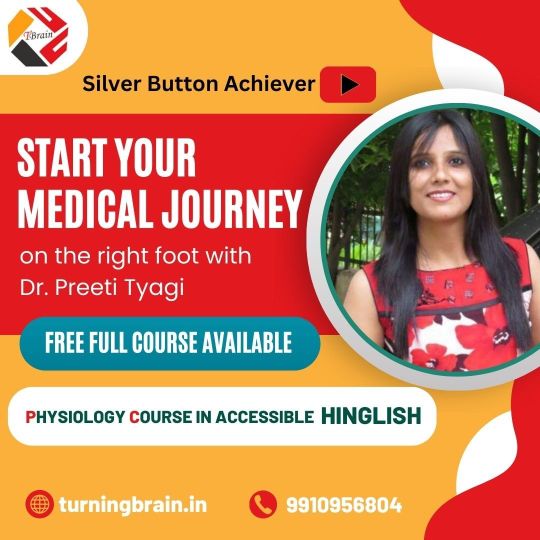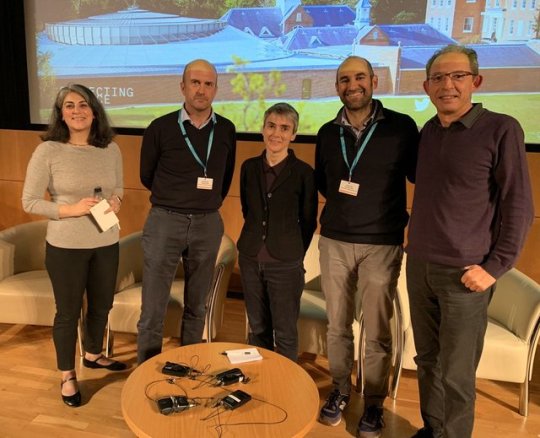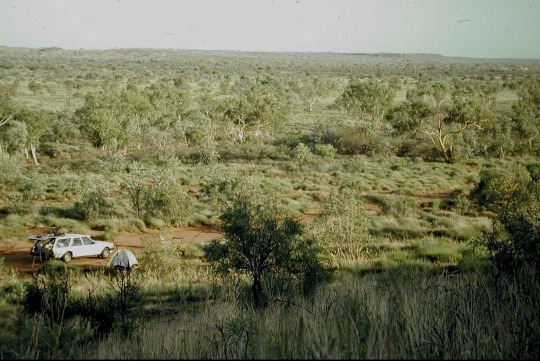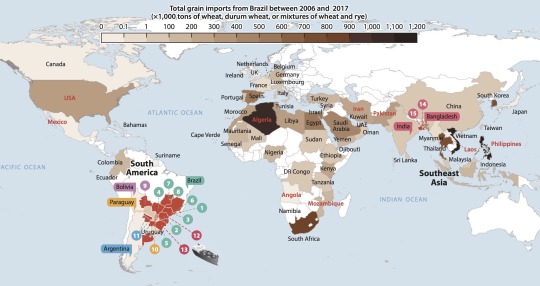#sciencelecture
Text

Calling all MBBS first-year students! 📚 Dr. Preeti Tyagi, the ultimate Physiology guru on YouTube, is here to guide you through your academic journey with her exceptional lectures in Hindi and English - and the best part? It's all FREE! 🎓
Don't miss out on this incredible opportunity to ace your studies with the best in the field! 💡
Follow For more !!
#physiologyexpert#MBBSJourney#FreeEducation#anatomy#drpreetityagi#physologyteacher#neetprep#sciencelecture#physiology#physiologyclasses#anatomystudy#anatomyexpertise#humananatomy#physiologicaldiscovery#drpreetityagilectures#physiologylectures#mbbs#medicaleducation#explore
0 notes
Video
No @ri_science inspired #ChristmasLecture is ever complete without the #Hydrogen baloon demo. @rutgersu Christmas Lecture was no exception but in a surprise twist, the second balloon was pushed down by the force of the first explosion and blew-up on the floor with a huge pop. Needless to say #dontdothis at home! Prof Dave Maiullo, Mark Croft are professionals. The students worked really hard and kept the show going really nicely. If you missed it, they are running it again in the spring or yoiu can simply see them in NYC at the @thatphysicsshownyc or @thatchemistryshow . #scientist #scienceexperiment #scienceexperiments #learningbyplaying #learningeveryday #michaelfaraday #lecture #sciencelesson #sciencelecture @andystechgarage #andystechgarage #andystem #evastem #atgstem #stemandy #atgstem #evastem (at Busch Campus of Rutgers University)
#scienceexperiments#atgstem#michaelfaraday#scientist#sciencelecture#stemandy#lecture#sciencelesson#scienceexperiment#learningbyplaying#learningeveryday#evastem#hydrogen#andystechgarage#andystem#dontdothis#christmaslecture
3 notes
·
View notes
Photo

#Repost @opendalegroup • • • • • • #blackhole #whitehole #singularity #physicsonly #physicsforlife #astronomyscience #astroworld #astrophysicslover #astrophysics ##blackholes #sciencemagazine #Scienceteen #sciencevideos #sciencelectures #sciencearticles #scienceteen #physics https://www.instagram.com/p/CCsJJoajkIw/?igshid=1cja4nddwsbun
#repost#blackhole#whitehole#singularity#physicsonly#physicsforlife#astronomyscience#astroworld#astrophysicslover#astrophysics#blackholes#sciencemagazine#scienceteen#sciencevideos#sciencelectures#sciencearticles#physics
0 notes
Photo

🌌 Evrenin İçi Boş Mu?: Eter Teorileri Uzay deyince akla yıldızlar, meteorlar, gezegenler, süper novalar ya da karadelikler geliyor. Bugüne kadar uzay denilince akla gelen şeyler sınırlıdır. Oysa akla gelmeyen bir şey daha var. Link bio'da. https://kozmolog.net/2021/09/16/evrenin-ici-bos-mu-eter-teorileri/ Yazan: Murat Tetik #timedilation #michelsonmorley #einstein #electromagnetic #wavepropagation #nasa #rocketscience #astrophysics #theoreticalphysics #generalrelativity #lorentz #michelsonmorleyexperiment #eterteorisi #ethertheory #tesla #relativitytheory #relativity relativitytheory #relativity #questioneverything #physics #physicslecture #physicslectures #interferometry #interferometer #sciencelectures https://www.instagram.com/p/CT4zgjLIXbJ/?utm_medium=tumblr
#timedilation#michelsonmorley#einstein#electromagnetic#wavepropagation#nasa#rocketscience#astrophysics#theoreticalphysics#generalrelativity#lorentz#michelsonmorleyexperiment#eterteorisi#ethertheory#tesla#relativitytheory#relativity#questioneverything#physics#physicslecture#physicslectures#interferometry#interferometer#sciencelectures
1 note
·
View note
Text
https://youtu.be/LnW_3tRoyMQ
youtube
#chemistry #biology #zoology #botany #exampreparation #sciencelectures #science
0 notes
Photo

Wellcome Genome Campus public event “Improving plants: Achieving food sustainability in a changing environment.” on October 16, 2019. @ACSCevents. Thanks to my colleagues and the audience for a great discussion.
Speakers
Dr Inanna Hamati-Ataya (University of Cambridge), Principal Research Associate, CRASSH http://www.crassh.cam.ac.uk/people/profile/inanna-hamati-ataya
Professor Ottoline Leyser (University of Cambridge), Director of the Sainsbury Laboratory https://www.slcu.cam.ac.uk/people/leyser-ottoline
Professor Sophien Kamoun, Group leader at The Sainsbury Laboratory Norwich http://www.tsl.ac.uk/staff/sophien-kamoun/
Professor Michele Morgante (University of Udine/Italy) https://appliedgenomics.org/en/about-us
Chair
Professor Cristobal Uauy (John Innes Centre Norwich), Group leader Designing Future Wheat / Genes in the Environment https://www.jic.ac.uk/people/cristobal-uauy/
Click here for Sophien’s talk: Plant health emergencies in the face of a changing environment.
1 note
·
View note
Video
Using a #robotic arm during the #ChristmasLecture preshow. No easy task! @rutgersu had a huge portfolio of items and experiments for the attending young #scientists . #scientist #scienceexperiment #scienceexperiments #learningbyplaying #learningeveryday #michaelfaraday #lecture #sciencelesson #sciencelecture @andystechgarage #andystechgarage #andystem #evastem #atgstem #stemandy #atgstem #evastem (at Rutgers School of Engineering)
#andystechgarage#robotic#andystem#atgstem#sciencelesson#sciencelecture#michaelfaraday#christmaslecture#scienceexperiments#learningbyplaying#learningeveryday#lecture#scienceexperiment#stemandy#scientist#scientists#evastem
1 note
·
View note
Video
Thanks to this tip from @ri_science inspired @rutgersu #ChristmasLecture we will never look at soda the same way again! Prof Dave Maiullo, Mark Croft and the students did an outstanding job and were incredibly entertaining. If you missed it this weekend they are running it again in the spring or yoiu can simply see them in NYC at the @thatphysicsshownyc or @thatchemistryshow . #scientist #scienceexperiment #scienceexperiments #learningbyplaying #learningeveryday #michaelfaraday #lecture #sciencelesson #sciencelecture @andystechgarage #andystechgarage #andystem #evastem #atgstem #stemandy #atgstem #evastem (at Busch Campus of Rutgers University)
#andystem#andystechgarage#learningbyplaying#christmaslecture#scientist#stemandy#sciencelesson#sciencelecture#scienceexperiment#evastem#atgstem#learningeveryday#michaelfaraday#scienceexperiments#lecture
1 note
·
View note
Text
Hello kids, I'm a biologist!
My presentation to the 9-10 year old children of the British International School of Tunis. March 21, 2019.
Click here for the slides. Photos on Facebook.
Here you can find notes, acknowledgements and links to the videos:
Slide 1. The action shot is from this interview with CropLife International. More on my background can be found on the Wikipedia English and French pages, and these interviews “Stranger in a strange land: the experiences of immigrant researchers” and ISMPMI Interactions InterViews. For popular science writing, check the PlantVillage article “https://medium.com/@plantvillage/keeping-up-with-the-plant-destroyers-9c0047899683”.
Slide 3. The Australian outback ~1994 with our clunky Ford Falcon. With @SaskiaHogenhout.
Slide 4. You go there to chase insects and instead insects start chasing you... #fieldworkfail #Australia
Slide 5. This Scanning Electron Microscopy shot of a tiger beetle head is courtesy of Charles R. Krause who captured it in 1982 on a Hitachi S-500 SEM.
Slide 6. Rivacindela eburneola, Cicindelidae, Coleoptera. I took this shot in 1994 at Lake Gilmore, Western Australia.
Slide 7. The fastest running insect in the world. BBC Earth.
Slide 8. Ed Yong’s National geographic piece on The Predator That Becomes Blind When It Runs After Prey.
Slide 9. Cornell University Daniel Zurek and Cole Gilbert study on how tiger beetles use their antennae to sense obstacles at high speed.
Slide 10. What’s in this picture? #PlantBlindness
Slide 11. The time-lapse video of potato plants infected by the Irish famine pathogen Phytophthora infestans was produced by Remco Stam.
Slide 12. I received the image of the potato farmer from Dr. Tarlochan Thind, Punjab Agricultural University. He is quoted in this story about potato late blight in India.
Slide 13. Different varieties of potato are either destroyed by the blight pathogen Phytophthora infestans or fully resistant (immune). The photo is courtesy of Vivianne Vleeshouwers at Wageningen University.
Slide 14. This stunning animation of the bacterium Xanthomonas infecting tomato plants was produced by students at Halle University working with Prof. Ulla Bonas.
For more suggestions of videos to use in classroom, check this Twitter feed.

0 notes
Photo

Special Relativity | Lecture 20 | Michelson Morley Journal Article: On the relative motion of the earth and luminferous ether | Part 1 In this video lecture we will discuss about the November 1887 article named "On the relative motion of the earth and lumniferous ether" by Michelson and Morley on the experiment which was conducted in 1887 to detect the presence of lumniferous aether (or ether). The experiment based on an interferometer was a major failure but this led to a completely new path for physics and finally in 1905 special theory of relativity came. We will discuss the historical background, the experimental setup, modifications made and finallly the observations and results of the experient. All the course materials and videos available on Scienceteen website Join Ramanujan Research Institute https://www.ramanujanresearchinstitute.org/ For offline free courses contact us. Credits: Article: American Journal of Science #relativitytheory #relativity #specialrelativity #specialtheoryofrelativity #physicslove #scienceexperiments #physicsexperiments #physics #michelsonmorleyexperiment #michelson #michelsonmorley #sciencevideo #physicslecture #physicslectures #interferometry #interferometer #sciencelectures https://www.instagram.com/p/CBgKGjojeR_/?igshid=1dky5q9xiic85
#relativitytheory#relativity#specialrelativity#specialtheoryofrelativity#physicslove#scienceexperiments#physicsexperiments#physics#michelsonmorleyexperiment#michelson#michelsonmorley#sciencevideo#physicslecture#physicslectures#interferometry#interferometer#sciencelectures
0 notes
Text
The Edge of Tomorrow — Plant Health in the 21st Century
ICPP2018 International Congress of Plant Pathology Plenary Session - Plant Health is Earth's Wealth, Monday, July 30, 2018.
Watch the talk on YouTube or click here for the slides.
Below are the sources I drew from to prepare this talk. I’m grateful to all contributors for their help.
Slide 1. The title "Edge of Tomorrow" was proposed by ISPP President Greg Johnson. It's inspired from the 2014 science fiction movie starring Tom Cruise and Emily Blunt.
Slide 2. “Medicine can cure you one day...” quip is from my colleague Cristobal Uauy.
Slide 3. Pathogens are a recurrent threat to agriculture… The example is wheat blast, which spread from South America to Bangladesh and then to India. The image is from this Hindustan Times article. The Figure below from Ceresini et al. illustrates the current distribution of wheat blast and highlights in brown the 65 countries that have imported wheat from Brazil in 2016/2017.

Slide 4. “When trees die, people die” is the title of this article from the Atlantic. Here is a similar article from Wired Magazine. The sudden oak death outbreak claimed the memorial wood that Paul McCartney established to his late wife.
Slide 5. The image was taken from Science magazine special series “Tomorrow's Earth”. The series calls attention to how we are shaping tomorrow's Earth.
Slide 6. Plant disease outbreaks have increased in frequency according to Fisher et al. Emerging fungal threats to animal, plant and ecosystem health. The figures are from the article and are based on data from ProMED database.
Slide 7. The world cloud was generated by Ksenia Krasileva based on ProMED mail.
Slide 8. Here is the 2013 Microbiology Today commentary "Genomics of emerging plant pathogens: too little, too late."
Slide 9. “Building resilience against crop diseases: a global surveillance system (GSS)” was held at Rockefeller Conference Center-Bellagio, Italy on 12-16 February, 2018. The organizers are Monica Carvajal, Joe Tohme, and Claudia Zuniga. Click here for an archive of the tweets #RFBellagio.
Slide 10 - The nextflu slide was copied from an online presentation by Richard Neher. Follow Richard on Twitter. Here is a link to nextstrain.
Slide 11. The FDA coordinates a network that releases the genomes of 20K foodborne bacterial strains to genbank per year. Here is the link to GenomeTrakr.
Slide 12. Our crowdsourcing approach to the UK ash dieback dieback outbreak was led by Diane Saunders, Kentaro Yoshida and Dan MacLean. The genome of the fungus was sequenced and released to the OpenAshDieBack web portal within months of the first detection of the outbreak. Here is one of the first news items on the topic. Check also the 2013 MacLean et al. article. For a more comprehensive study on the fungus check McMullan et al.
Slide 13-16. Many thanks to Tofazzal Islam and his team for their invaluable input and for making the #openwheatblast project happen.
Here is the Islam et al. 2016 paper. Many thanks to Daniel Croll and Pierre Galdieux for leading the early analyses.
Slide 17. Genotyping by multiplex amplicon sequencing is performed in collaboration with Kurt Lamour and Floodlight Genomics. Their slogan is "Genotype The World". The work was led by Sarai Reyes-Avila, Emilie Chanclud, and Joe Win with contributions from Daniel Croll.
Slides 18-21. Our understanding of plant-pathogen interactions has matured around a number of fundamental concepts. Check Dodds and Rathjen 2010, Win et al. 2012. Download the animated slides via @figshare.
Slide 22. Maqbool et al. 2013. De la conception et al. 2018.
Slide 23. The ICPP talks I referred to are by Josie Maidment and Juan Carlos De la Conception. Follow Josie and Juan Carlos on Twitter.
Slide 24. For our work on synthetic R+ genes, check the papers of Segretin et al. 2014 and Giannakopoulou et al. 2015. Check also the work of Roger Innes on using decoys to expand the recognition specificity of a plant disease resistance protein. See also the Giannakopoulou et al. commentary on the decoy strategy and other approaches to retool the plant immune system (see Figure).

Slide 25. The figure is from a recent review on CRISPR crops by Langner, Kamoun and Belhaj. Check our also how a transgene-free powdery mildew resistant tomato can be rapidly generated by removing a piece of DNA. Back in 2012, we argued that plants with DNA deletions should not be viewed as GMO.
Slide 26. Sadly, aspects of the 2006 cult movie idiocracy turned out to be prophetic. A major challenge for all scientists is the global trend towards populism and away from science and reason. Here are links to the Guardian article "time to burst the biomedical bubble" and the associated report by Jones and Wilsdon.
Slide 28. Here is a link to DORA-the San Francisco Declaration on Research Assessment. DORA recently released a road map towards improving research assessment. The preprint server bioRxiv has experienced remarkable growth since its launch in 2013 with now over 2000 papers posted by month. Many important papers in the the field of molecular plant-microbe interactions are regularly posted on biorxiv.
Slide 29. Michelmore, Coaker et al. white paper “Foundational and translational research opportunities to improve plant health”. Here is a link to the supplementary table, which provides an overview of the topics discussed at the workshop.
Slide 30. Thanks to the ICPP International Advisory Committee for their input. The word cloud was generated with Wordle based on the IAC suggestions.
Slides 30-31. Many thanks to my lab members and other colleagues at The Sainsbury Laboratory. I'm also indebted to many colleagues for their ideas and collaborations. Most relevant to this presentation, and in addition to the colleagues mentione dabove, is the #BLASTOFF trilateral collaboration with Ryohei Terauchi and Mark Banfield.
Finally, check this amazing sketch drawn by Robin Choudhury during the talk!

0 notes
Video
#gravitationallensing explained with the help of a glass prop at the preshow exhibit before the #rutgerschristmaslecture last year. For similar experiments and events check-out the upcoming #rutgersday and @thatphysicsshownyc or @thatchemistryshow Promise you will love it! Inspired by #royalinstitution #ChristmasLecture @rutgersu . #scientist #scienceexperiment #scienceexperiments #learningbyplaying #learningeveryday #michaelfaraday #lecture #sciencelesson #sciencelecture @andystechgarage #andystechgarage #andystem #evastem #atgstem #stemandy #atgstem #evastem (at Rutgers University CMSCE)
#scienceexperiment#rutgerschristmaslecture#learningeveryday#lecture#sciencelecture#christmaslecture#rutgersday#michaelfaraday#scienceexperiments#scientist#andystechgarage#stemandy#gravitationallensing#learningbyplaying#andystem#evastem#sciencelesson#atgstem#royalinstitution
0 notes
Photo

Teaching materials for "Effectors and Plant Immunity" session in the 2017 TSL Summer School. Here, you will find all the useful stuff like course materials, papers, handouts, tips, etc. Please feel free to download and use them. Click here to link up to the GitHub page.
0 notes
Photo

Can a biologist fix a smartphone?—Just hack it!
“This example illustrates the limits of systems approaches to studying living organisms. Organisms are not optimally designed. They are messy. They have evolved through evolutionary tinkering. They suffer from the constraints of being linked through the unbroken chain of heredity to a series of ever more distant ancestors. This fundamental concept is what most vividly differentiates biology from design and engineering.”
0 notes
Text
Brief introduction to fungal biology and genetics
Pre-seminar session with the TSL/JIC students in preparation for John Taylor’s visit on April 27-28.
Below are the topics we discussed and some of the relevant links.
Life cycle of fungi. Fungi can reproduce asexually by fragmentation, budding, or producing spores, or sexually with homothallic or heterothallic mycelia.
The one fungus – two names mess. But is there a new age of enlightenment?
Neurospora life cycle. “Neurospora species are all haploids, spending most of their life cycles in the haploid state. However, the various species of Neurospora show one of three different life cycles called heterothallic, homothallic or pseudohomothallic. The heterothallic N. crassa is the most thoroughly studied species.”
More on Neurospora crassa on wikipedia.
Beadle and Tatum – One gene, one enzyme hypothesis. “These experiments founded the science of what Beadle and Tatum called ‘biochemical genetics.’ In actuality they proved to be the opening gun in what became molecular genetics and all the developments that have followed from that.”
John Taylor’s classic 1990 paper on fungal DNA barcoding has >20K citations. And it’s NOT in a glam mag ;)
~20 years later, population genomics of wild Neurspora enabled analyses without a priori bias. Check Ellison et al. 2011. Gladieux et al. 2015.
Evolution of clonal fungi. Restrained recombination? We know so little yet some fungi have been clonal for hundreds of millions of years.
The parasexual cycle.
Learn how a retroelement can help an effector gene persist in an asexual population despite repeated deletions. See also discussions in Raffaele and Kamoun, 2012. Dong et al. 2015.
RIP - repeat-induced point mutagenesis is so cool. Mutations are not random across the genome. And it’s not just in Neurospora - see for example Daverdin et al. 2012.
Absence of RIP pathway may have contributed to massive genome expansion in powdery mildew fungi.
Internuclear gene silencing in Phytophthora or the sort of experiments you can do with heterokaryons.
0 notes